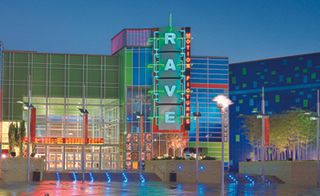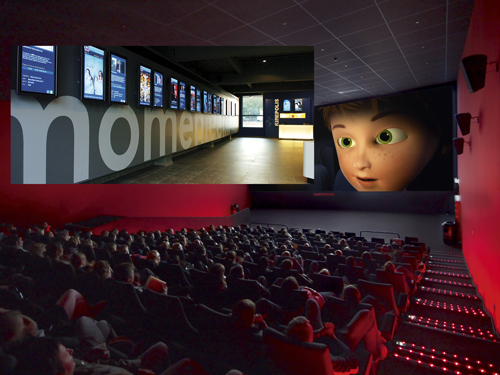Kinepolis features digital signage in its cinema lobbies as well as fully digital projection of feature movies. The 23 Kinepolis theaters in Belgium, France, Spain and Switzerland had 22 million visitors last year, and every Kinepolis multiplex is equipped with Barco’s ACS-2048 switcher and a hi-def satellite receiver system for the presentation of alternative content– illustrating the concept of “narrowcasting” to the big screens in theaters.The Cinema Market was one of the first to incorporate digital signage, and DOOH, into public spaces. The logic and logistics of narrowcasting to movie theater lobbies does not require much of a stretch, and several large digital cinema projector providers in the market leverage and cross-market their strength in providing images to both the big cinema screen (digital feature movie projection) and the smaller screens in the venue (movie promos, ads, etc).
Arsenal Media has been heavily involved in creating content for digital signage systems in many markets– not just for lobbies of movie theaters, but they see the cinema market as being at the crossroads of several trends.
"I’ve always seen the movie theater environment as a powerful content destination that would one day open up many opportunities from a digital signage and experiential perspective,” said Denys Lavigne, president, Arsenal Media. “We may now be at an intersection where the evolution of the movie theater as a digital destination crosses a more mature and refined digital signage industry. The resulting concepts might define the new standards of display installations, not only in cinema lobbies, but in public and retail environments as well.”
But even as digital signage has been a staple in the lobbies of movie theaters, when major industry players start talking about narrowcasting content to the big screen in the movie theater not just the smaller screens, something important is taking place. How is Cinema related to digital signage? Inextricably– going forward. Why? Because in 2012, the kind of disruption to the advertising industry, and mobile phone industry, that has changed media platforms and business models forever (the kind of media disruption that in fact spawned the digital signage market) is now visiting the movie exhibition industry. After more than a decade of “hurry up and wait” in the cinema market, the analog-to-digital transition that most media started years ago is now achieving critical mass for movies.
"Major industry players are talking about narrowcasting content to the big screens in the movie theaters not just to the smaller screens."For years, theater owners were slow or reluctant to transition away from analog film projection to digital, because it was they who had to foot the cost of installing digital gear, while it was clearly the movie studios and distributors who would be the ones saving huge amounts of money on distribution costs– and WWII era laws prevented the two camps from cooperating to share costs and savings. Add to the mix Hollywood studio chiefs’ caution, as they observed the near-decimation of the recorded music business wrought by a swift transition to digital in that industry. The result: the digital conversion in the movie business has– until now– been neither a revolution nor much of an orderly evolution.

Rave Motion Pictures, the fifth largest chain of movie theaters in the United States, with 61 locations in 21 states, was a pioneer in the adoption of digital projection for feature movies. But the digital conversion does not stop there. With support from Christie Managed Services, Rave provides a Lobby Entertainment Network (LEN) air show display over concession areas, more than 500 digital menu boards, LED way-finder signage, and extensive LED signage in its box offices. Increasingly, movie theaters will leverage both on-theater screen networks as well the inter-venue networks to provide and promote alternate content as well as Hollywood features.But this year the movie business is going through not an organized migration to digital but a sudden, major disruption unleashed by decades of built-up tension and antiquated business models. The move to all-digital projection on the big screens is no longer the “long pole in the tent”. As the result of new developments in digital movie equipment financing schemes fast-tracked over the past 12 months, that transition is almost complete. Now, it’s about movie theaters competing for consumers’ attention with powerful new media platforms including game consoles that double as movie servers, VOD (Video on Demand), all the way down to smartphones and tablets that play streamed movies. Movie houses will survive, but we will soon see a very different movie landscape as commercial movie theaters– the ones who wish to survive the digital transition– will soon diversify away from just showing feature films and toward more content sharing with other media. And they’ll do that by narrowcasting content to select screens at select days and times, not by shotgun-scattering content out to sit for weeks in theaters across the country regardless of the local demand for that content. “Narrowcasting’, and “Dayparting”. Ever heard those terms– so familiar to us in the digital signage world– used when talking about the movie business? You have now.
- At a major presentation entitled “A Change is Going to Come” at the Technology Summit on Cinema, on the eve of the NAB show in April, Chris McGurk, Chief Executive Officer of Cinedigm, outlined what he saw as the future of Cinema. Cinedigm is a huge, dominant distributor of movies and other content to theaters in the U.S. Pointing out that only 5 % of seats are occupied in theaters Monday-Friday (15% on a yearly basis), and given big studios’ focus on blockbuster movies, McGurk stressed that we have to find new content to fill those seats– live sports, music, interactive. A more “ targeted, narrowcast” market, said MCGurk. “Digital cinema can a be more ‘rifle’ approach not shotgun approach. Digital allows us to target the marketing. While enhancing exposure as only a theatrical release can do.”
At a major presentation entitled “A Change is Going to Come” at the Technology Summit on Cinema in April, Chris McGurk, Chief Executive Officer of Cinedigm, outlined what he saw as the future of Cinema– including a move to “Narrowcasting” to the big screens in movie theaters.McGurk added that this new kind of content can use social media to draw people in. And that there are myriad ad revenue possibilities. “Narrowcasting in the theater is the new call to arms,” said McGurk.
Not sure how this affects the larger digital signage and DOOH business? As Digital Signage magazine columnist Laura Davis-Taylor and I stress continually in our analysis in this magazine, digital signage and DOOH can only be understood in the context of the larger media disruptions that are taking place in markets whose size dwarf our more parochial sphere. The smartphone market alone is already hugely disrupting the (originally) disruptive digital signage market. The TV market, also, is seeing shifting content delivery models that are sweeping over all media consumption. And now, movies– what many thought the last bastion of old-school, Hollywood controlled and nurtured content– are undergoing massive changes in business models.
Focusing back on the digital signage part of the equation that involves non-big screen content, I asked Denys Lavigne how digital signage could fit into a next-generation movie theater environment where the competition for consumers’ eyes is fierce.
“If there is one context where we might observe true innovation in digital signage over the next five to ten years, and on a large scale, it is in movie theaters,” said Lavigne. “Digital signage will always play a supporting role in the cinema world. And as the cinema offering continues to diversify – as the experience becomes more integrated with other media, digital signage as a media must find innovative ways to leverage the emotional bond that connects audiences with the stars and the stories, and extend the experience into new platforms. This means more integrated content experiences before, during and after the show; more opportunities to engage fans with interactive and experiential extensions of brands and media properties.”
Tom Bert, Product Marketing Manager at Barco, commented that “in the cinema of the future, content will be ubiquitous. Independent of whether you’re showing on the big screen, small lobby screen or mini smartphone screen of the moviegoers; it will be possible to share the same content and formats. What we call digital signage today will be the hub of this wider eco-system. Digital signage systems have all the tools on board to create, manage and distribute many types of content. Furthermore, they do this in a very easy-to-use way; thereby not only enabling narrowcasting in cinema, but truly putting it in the hands of the exhibitors.”
Fast-changing cinema business models including the challenge of adapting to the crossover of media platforms now have all the major players rethinking the boundaries between TV, Cinema, OOH, and DOOH. Digital signage is an important subset of DOOH (Digital Out of Home), and the movie theater market, going forward, holds the promise of “narrowcasting” providers becoming involved in providing content and systems integration for the big screens inside the theaters as well as the small “digital signage” screens in lobbies.
(Editor’s Note: For a comprehensive, in-depth report by David Keene on the digital transition in the Cinema market, and its implications for all media including DOOH, click here.)










